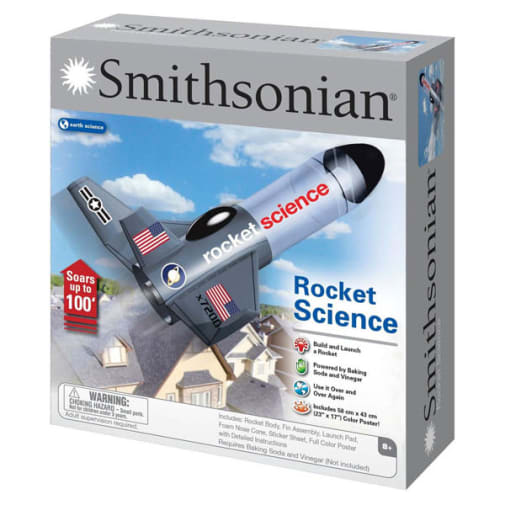Assemble, decorate, and launch your very own rocket using vinegar and baking soda as your fuel. Children will enjoy this kit because it is uncomplicated and produces an exciting result. The kit includes a plastic fuselage, foam wing assembly, launch tube, launch plug, base, sticker sheet, and poster with instructions. Simply slide the wing assembly onto the fuselage, attach the launch plug to the base, push the launch tube into the launch plug, pour baking soda into the tube, pour vinegar into the fuselage, slide the launch tube into the fuselage and shake the whole thing! Step back and watch your rocket launch into the sky. This rocket flies up to 50' depending on the amount of fuel you use. Baking soda and vinegar not included.
Smithsonian Rocket Science Kit
SKU
024238
Grade 3-AD
These icons are designed to help you quickly understand and learn important information about our products.
Teaching Method
Traditional
Teacher-centered curriculum commonly used in classrooms that may include a text, teacher manual, tests, etc.
Charlotte Mason
A methodology based on the work of a 19th century educator who maintained that children learn best from literature (Living Books), not textbooks.
Classical
A methodology based on the Latin Trivium (three stages of learning), including the grammar stage (memorization and facts), logic stage (critical thinking), and rhetoric stage (developing/defending ideas).
Unit Study
A thematic or topical approach centered around one topic that integrates multiple subject areas.
Montessori (Discovery)
A methodology based on the work of a 20th century educator that emphasizes student and sensory-driven discovery learning and real-life applications.
Other
Other methodologies
Religious Content
Secular
Contains content contrary to common Christian beliefs (i.e. evolution).
Neutral
Avoids religious or theoretical topics or presents multiple viewpoints without preference.
Christian/Religious
Faith-based or including instructional religious content.
Learning Modality
Auditory
Learns through listening, talking out loud or reading out loud.
Visual
Learns through seeing, prefers written instructions and visual materials.
Kinesthetic/Tactile (Hands-On)
Learns through moving, doing and touching.
Multi-Sensory
Curriculum that employ a variety of activities/components.
Presentation
Sequential
Curriculum progresses through well-defined learning objectives. Emphasizes mastery before moving to the next topic.
Spiral
Topics and concepts are repeated from level to level, adding more depth at each pass and connecting with review.
Conceptual/Topical
Focus is on the “why,” often with a unifying concept as well as specific skills; coverage may be broader.
Teacher Involvement
Low Teacher Involvement
Student-led materials; parent acts as a facilitator.
Medium Teacher Involvement
A mix of teacher-led time and independent student work.
High Teacher Involvement
Teacher-led lessons; may utilize discussions, hands-on activities and working together.
Additional Materials Required
No other materials needed
Everything you need is included.
Other Materials Required
There are additional required resources that are a separate purchase.
Other Materials Optional
There are additional resources mentioned or recommended but are not absolutely necessary.
Consumable
Consumable
Designed to be written in; not reusable.
Non-Consumable
Not designed to be written in; reusable.
Our Price
$19.99 $19.99 $17.95
Rainbow Savings: $2.04
Description
Publisher's Description of Smithsonian Rocket Science Kit
Official Smithsonian licensed Rocket Science. Build and launch a rocket, powered by baking soda and vinegar. Use it over and over again. Soars up to 100 feet! Includes rocket body, fin assembly, launch pad, foam nose cone, sticker sheet, full color poster with detailed instructions. Ages 8 years and up.
Details
| Product Format: | Other |
|---|---|
| Grades: | 3-AD |
| Brand: | Smithsonian |
| EAN/UPC: | 042409522769 |
| Length in Inches: | 12 |
| Width in Inches: | 10.75 |
| Height in Inches: | 3.25 |
| Weight in Pounds: | 1.05 |
Videos
Reviews

